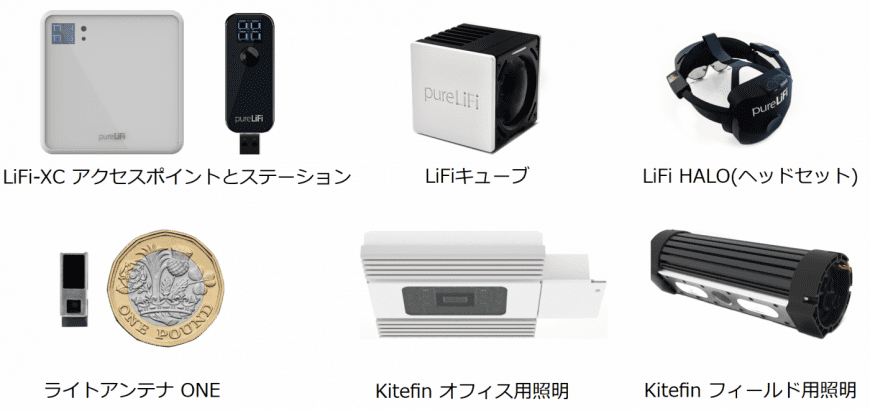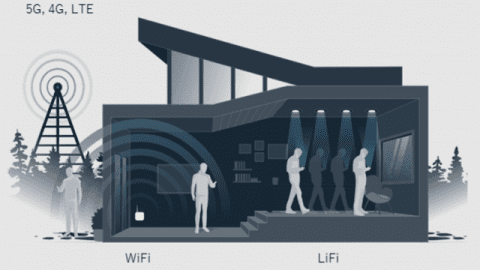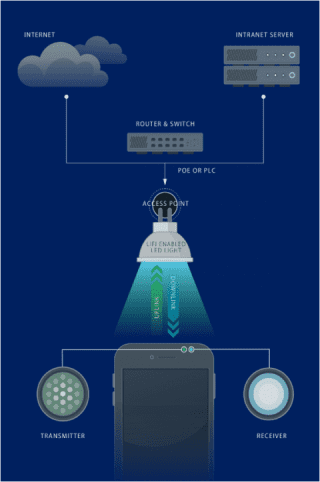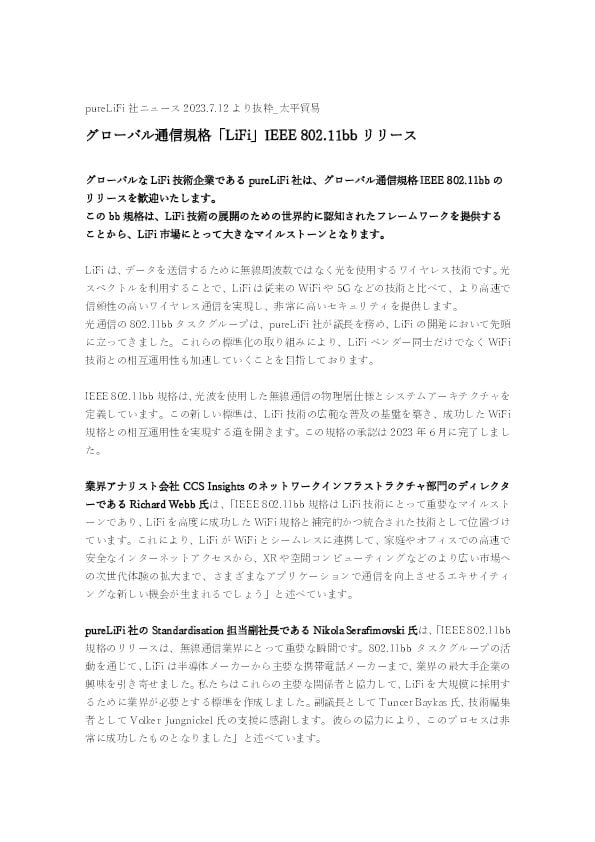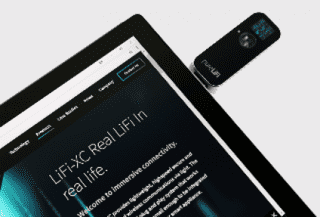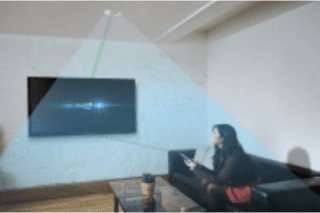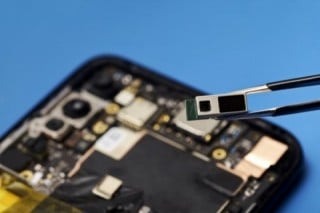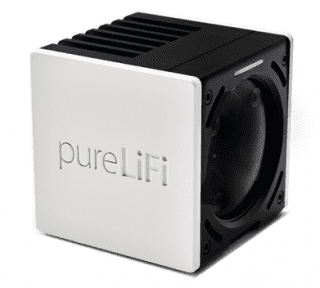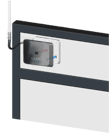
pureLiFi Ltd. (Scotland)
Pure Raify (Scotland)
Pioneer manufacturer of LiFi technology established in 2012
Contribution to the release of the global optical communication standard 802.11bb
A venture company from the University of Edinburgh founded by Harald Haas, a pioneer of LiFi technology.
Taihei Boeki(Optical Devices Section)has been acting as a Japanese agent of pureLiFi since December 2018.
Visible light/optical wireless communication LiFi
What is LiFi?
Please try to imagine.I wish I could connect to the internet from all the lights in this room.
LiFi is an abbreviation for "Light Fidelity" and is a high-speed wireless communication technology that uses light.
LiFi is an abbreviation for "Light Fidelity" and is a high-speed wireless communication technology that uses light.
It is a technology to build a two-way network wirelessly by modulating light such as LED lighting at high speed instead of radio frequency (RF) for data such as voice and video.
As a new optical wireless technology, Professor Harald Haas of the University of Edinburgh (UK) (founder of pureLiFi) introduced it for the first time in a TED Global Talk (US) in 2011.
By using pureLiFi's LiFi technology , LED lighting, etc., can be modulated at such a high speed that the human eye cannot perceive it.
In addition, LiFi can support not only visible light but also optical communication using invisible near-infrared rays.
As a new optical wireless technology, Professor Harald Haas of the University of Edinburgh (UK) (founder of pureLiFi) introduced it for the first time in a TED Global Talk (US) in 2011.
By using pureLiFi's LiFi technology , LED lighting, etc., can be modulated at such a high speed that the human eye cannot perceive it.
In addition, LiFi can support not only visible light but also optical communication using invisible near-infrared rays.
Since it does not use RF that uses radio waves, there is no effect of interference such as electromagnetic interference, and high-speed and stable communication with high security is possible.
Basic setup
The basic setup is to install a LiFi dedicated driver (LED control) and an access point (receiver) for lighting such as LEDs. On the terminal side, connect a transceiver such as a LiFi-dedicated USB dongle to a computer, tablet, or various devices.
High-speed wireless communication can be performed as an optical signal using light between a transmitter/receiver such as an LED lighting (access point) and a USB dongle.
In addition, pureLiFi's LiFi-XC series has verified that communication is possible even in direct sunlight during the day (77,000 lux outdoors) and in dim indoor lighting (illuminance level of at least 60 lux with current technology).
*Lux (lx) is an index that expresses brightness. The higher the number, the brighter the light.
Complementing hybrid wireless communication
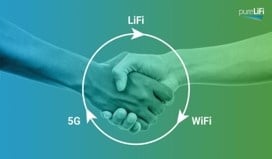
LiFi is not intended to replace RF wireless technologies like WiFi.
In the future, LiFi can be integrated with other RF systems like WiFi for a seamless auto-switching setup, ensuring always-on connectivity and the best possible user experience.
LiFi does not use radio frequency (RF) using radio waves, so it is not affected by electromagnetic interference or interference. The linked heterogeneous network will be a secure and reliable linked wireless network, and will be able to realize the communication functions of smart buildings, intelligent transportation (ITS), and smart cities.
Optical wireless communication technology for next-generation wireless devices connects the world
Imagine a world where LiFi is integrated into every lighting device, indoors and outdoors.

Since a LiFi wireless communication network is formed by multiple LED lighting devices, a small communication area can be easily expanded.It can be deployed in a wide range of next-generation applications such as smart devices, AI, VR/AR, and edge computing.

- Enterprise wireless solution
- Industry 4.0 (IoT, FA robot)
- Secure network
- Digital Signage
- Smart homes, offices, buildings, cities, infrastructure
- VR/AR/MR
- Autonomous travel transportation
- Device-to-device communication
- Indoor positioning
- Mobile payment
Features of LiFi
Fast / bandwidth / reliability

LiFi is data communication using visible light and infrared waves.Visible wavelengths have an optical spectrum that can communicate more information than radio frequencies (RF).
Secure communication

The area where the light is emitted is the range that can be communicated, and since the light does not penetrate opaque materials such as walls, it is possible to determine the accessible communication area and prevent information leakage.
By managing access restrictions in communication areas with small cells, it is possible to restrict access to personal information and confidential company information, and protect privacy with high security.
Radio interference/crosstalk free

LiFi uses light as a communication medium, so it does not interfere with radio frequencies such as WiFi. It also doesn't require a visible light spectrum license at this time, so it's easy to install and increase bandwidth.
EMI (electromagnetic interference) free

LiFi is about using the light spectrum.Since there is no EMI (electromagnetic interference) effect in the optical spectrum, LiFi is suitable for use in areas susceptible to electromagnetic waves.
It provides wireless data connectivity in environments where RF is undesirable, unsafe, or impossible, such as petrochemical plants, hospitals, manufacturing plants, nuclear power plants, underground mines, and underwater.
Location information service

An access point is assigned an IP address. Every light in a LiFi network has a unique identifier, so it can be located where it sends and receives.
It can be built for location-based services, marketing, or even advanced geofencing that automatically delivers alerts when removed from a particular location.
*Geofencing is a mechanism to create a virtual fence in a specific area.
Low latency

Since it is not affected by radio interference, it can improve communication delay compared to WiFi.
LiFi is wireless communication with military-grade security.
Light cannot penetrate walls or leak through materials such as canvas or curtains, so it can be trapped within a space.This eliminates the possibility of cyberattacks from outside the range of the light or from outside the room.
LiFi provides users with the privacy and security that modern personal and business networks require.
Light cannot penetrate walls or leak through materials such as canvas or curtains, so it can be trapped within a space.This eliminates the possibility of cyberattacks from outside the range of the light or from outside the room.
LiFi provides users with the privacy and security that modern personal and business networks require.
Secure communication
Radio interference/crosstalk free
Global optical communication standard 802.11bb

As chair of the ieEE802.11bb task group, pureLiFi helped set the goal of extending 802.11 to include light media.
Since the Task Group was launched in 2019, the standard under development has gained international support and will become a fully approved global standard for optical communications in 2023.
Global LiFi technology company pureLiFi welcomes the release of the IEEE 802.11bb global communications standard.The bb standard represents a major milestone for the LiFi market as it provides a globally recognized framework for the deployment of LiFi technology. |
Product list pureLiFi

Custom / semi-custom
We are deploying it for various applications.
Please let us know your use case, data rate, communication distance, etc.
We will propose the best LiFi solution.
Video pureLiFi
Presentation for optical wireless communication LiFi factory Taihei Boeki
pureLiFi demonstrate Gigabit LiFi at MWC 2019
Why the world needs LiFi
Download
2006 Press Release LiFi_jp (706KB) |
2306 Lift Antenna ONE_en (1648KB) |
2306 LiFi Cube_en (1430KB) |
2306 LINXC 5G LiFi Bridge (1585KB) |
2302 Kitefin_en (1383KB) |

